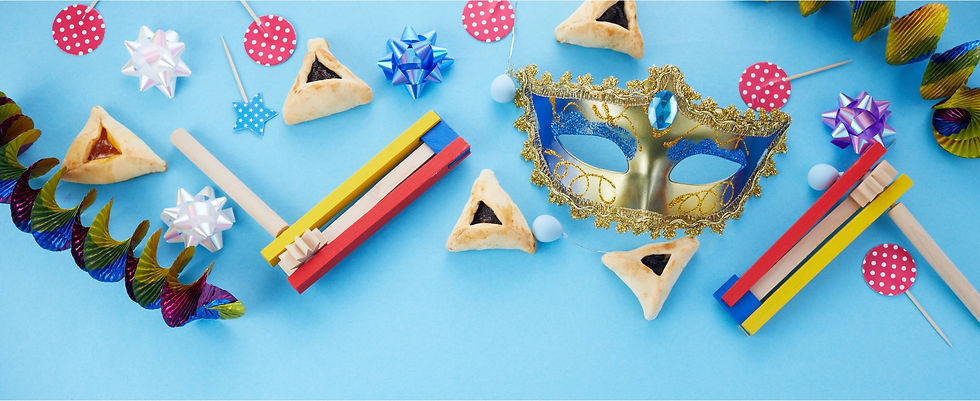
PURIM
PURIM 5785/2025
In 2025, Purim will begin on the evening of Thursday, March 13, and end on the evening of Friday, March 14.
Purim is celebrated on the 14th of the Jewish month of Adar, which falls sometime between February and March. It occurs approximately one month before Passover. When there is a leap year in the Jewish calendar and there are two months of Adar (Adar I and Adar II), Purim is celebrated on the 14th of Adar II. In, 5782 (2022), our Jewish calendar featured two (2!!!) months of Adar. This might sound very confusing but indeed the purpose of the two-Adar Jewish year that pops up every few years is to make the months and the related holidays less confusing. As the Jewish calendar is a lunar calendar, each month has fewer days than a Gregorian calendar month, resulting in a shift in the seasons unless a “leap month” is occasionally added. Without a year with two Adars, Passover would eventually occur in the summer, fall or winter in the Northern Hemisphere. Likewise, Hannukah would also dance around the secular calendar.
We celebrate this annual holiday with joyous festivities—Purim carnivals for youth, Purimspiels, the reading of the megillah (Book of Esther), the drowning out of the villain Haman’s name with noise-making groggers, costumes, masks and plenty of tasty treats. The most famous baked treat is the hamentaschen, which is triangular in shape (to represent the arch villain’s hat) and stuffed with a filling.
In our 2025 update, we recommend your reading some of The Nosher’s hamentaschen recipes and tricks of the trade. Enjoy!
-
Great hamentaschen recipes: both traditional and exotic…from coconut hamentaschen to shashuka-flavored ones can be found in the whatjewwannaeat.com website. Click here for the yummy treats.
Although the story is one that describes a serious threat to the Persian Jewish people many centuries ago, Purim is a day of feasting and merriment as the story ends with our people being saved. Humorous skits, masquerades, carnivals and clowns have become part of the “staple” of Purim tradition in modern times.
Even if you don’t know the entire story about the Jewish holiday of Purim, you will probably be familiar with some of its most famous attributes:
-
Treats such as the three-sided poppy seed/prune/jam-filled pastries (Hamentaschen) are enjoyed as well as gifted (see Purim baskets below).
-
The public reading of the Book of Esther (megillah).
-
Stamping out and or shouting out and or “Grogging Out” the name of the story’s villain, Haman, whenever his name is recited during the reading in order to limit Haman’s impact.
-
Bringing Purim baskets of at least two food items to neighbors, friends and family (mishloach manot).
-
Giving tzedakah (charity).
-
Children wearing costumes (and often adults).
-
Revelry, including drinking for adults
So exactly what is Purim? What is the story around which this holiday is built?
It is a celebration of the saving of the Jewish people when we were governed by the Persian King Ahasuerus. A villainous government official, Haman, conspired to have us executed; but due to the bravery of the king’s Jewish wife Esther and her cousin Mordecai, we were saved. Or as the editor of whatjewwannaeat.com writes:
Anyhoo, if I had to sum up the majority of Jew holidays, it would go something like this. Someone tries to wipe us out, by some ridiculous miracle we triumph, despite lack in numbers and stature, so we rejoice by eating and drinking. And repeat. Purim is no different. Esther, a sassy young Jew living in Persia, saves all the Jews from the King’s evil adviser Haman’s devious plans of extermination. So we rejoice with tons of rowdy parties, costumes and hedonism. Hence why Purim is known as the Jewish Mardi Gras or Halloween. Sign me up! To celebrate, we make tasty triangular cookies called hamantaschen filled with goodness to represent the fashionable three-cornered hat Haman was known to sport. Poppy seeds and prunes are the most common fillings, but I got a little feisty and went with the priciest jam I could find at Whole Foods. And then I dipped them in chocolate. Just because I can.
Here are some sources of more information about Purim:
-
From MyJewishLearning.com: Purim 101
-
From ReformJudaism.org: Purim
-
From Chabad: Story of Purim
-
From Schechter: Esther's Megillah
Purim Basket Themed Ideas
One major tradition for Purim is mishloach manot, translated as “sending of portions.” We find the origin of this custom in the Book of Esther, which describes Purim as a time of feasting and gladness. Everyone over Bar/Bat Mitzvah age is supposed to give a basket to at least one person—a neighbor, friend and/or relative. Traditionally, this is often done through a third party. The basket should hold a minimum of two different food items that are ready to eat.
The website kosher.com suggests 50 different themes for your baskets listed here.




